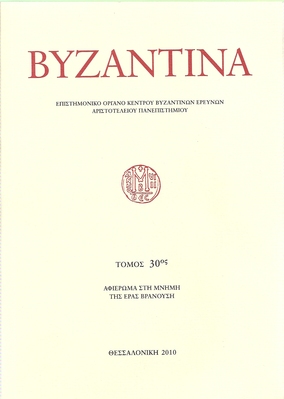Ανεικονικός διάκοσμος και μια πρώιμη βυζαντινή επιγραφή από τον ναό της Αγίας Αθανασίας στο Ριζοκάρπασο
Part of : Βυζαντινά : επιστημονικόν όργανον Κέντρου Βυζαντινών Ερευνών Φιλοσοφικής Σχολής Αριστοτελείου Πανεπιστημίου ; Vol.30, No.1, 2010, pages 203-229
Issue:
Pages:
203-229
Parallel Title:
Uniconic decoration and an early byznantine inscription from Ayia Athanasia at Rizokarpaso
Author:
Abstract:
The single aisled vaulted church of Ayia Athanasia is situated in a wooded area, approximately 2 km east of the Turkish occupied village of Rizokarpasso. Built into the north wall inside is a tomb with an arcosolium. the arch of which appears also in the wall outside. Almost half of the tomb is placed in the sanctuary and half in the main church. A similar feature is to be found on the south wall at the five-dome church of Ayia Paraskevi at Yeroskipou village at Paphos which is dated in the 9th century.The small chapel was ready to collapse, and the Department of Antiquities of the Republic of Cyprus undertook restoration work in 1973. Unfortunately rainwater penetrated inside due to the chapel's abandonment since 1974 after the Turkish invasion; the water removed plaster, and a Greek inscription appeared at the north wall:K(ΥPI)E Ω ΘΕ E[N] ΤΗ TPHTH ΩΡΑ ΜΕΤΑ [ΤΩ]N ΑΠΩCTΩΛΩ <N.> CY <EI H> Α<Μ>ΠΕΛΩC H AΛΗΘΗΝΗ H BACTACACA ΤΩ[Ν]4. ΚΑΡΠΩ<Ν> ΤΗΣ ΖΩΗC ΠΑΡΘΕΝΕ ΘΕΩΤΟΚΕHere is our transcription:Κ(ύρι)ε ώ Θε(ός). έ[ν] τη τρήτη ώρα μετά [τώ]ν Άπωστώλω<ν>. Συ <εί ή> α<μ>πελως ή άληθηνή. ή βαστάσασα τώ[ν]4. καρπώ<ν> τής ζωής. Παρθένε,Θεωτόκε.The inscription is actually a combination of Troparion and Theotokion of the Liturgy of the Hours at Terce. The inscription dates approximately to the first half of the 9th century but an earlier date in the 8th century is not impossible.In 1.2 Άπωστώλω<ν> and α<μ>πελως for 'Αποστόλων and άμπελος respectively are spelled without nasals. These spellings apparently are due to the local, pronunciation, reflecting widespread phenomena in Cypriot Greek, attested here for the first time in a Byzantine period text.Below the inscription there are three painted crosses and two unidentified stylized, ferocious animals, with probably apotropaic character. A gemmed cross is to be found on the south wall along with other crosses in other places of the church. This decoration is most probably related to the iconoclastic controversy in Byzantium (726-787. 814-842). The inscription and the decoration of the church belong to the same period.Written sources and archaeological evidence, like the three famous pre- iconoclastic wall mosaics (Kanakaria, Angeloktistos. Panaghia Kyra) indicate that the iconoclastic controversy did not prevail in Cyprus, due to the peculiar political situation between the Byzantine Empire and Arab Caliphate. The present important findings nevertheless testify a certain impact of the iconoclastic ideas in Cyprus, but do not overrule the fact that Cyprus remained faithful to the veneration of icons.
Subject (LC):
Notes:
Περιέχει 15 εικόνες, Το άρθρο περιέχεται στο αφιέρωμα στη μνήμη της Έρας Βρανούση, Στην Ελένη, στον Μιχάλη. στον Παντελή και στη Μαρία-Εμμέλεια. που συνοδοιπορούν εδώ και χρόνια στο πικρό ταξίδι της "επιστροφής" στα αγαπημένα χώματα της Αμμοχώστου και της Καρπασίας.




